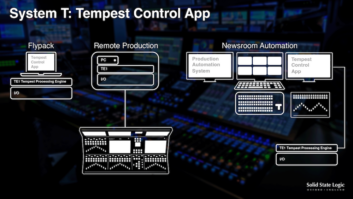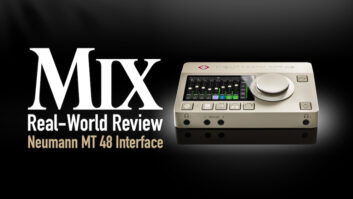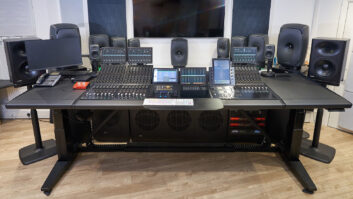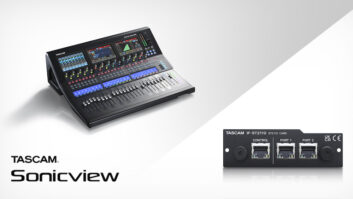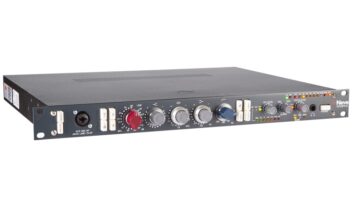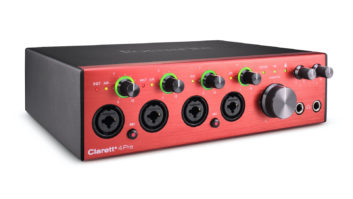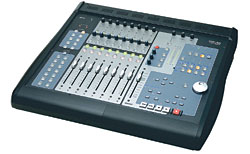
A control surface/FireWire audio/MIDI interface describes most of
what Tascam’s FW-1884 does, but there wouldn’t be enough space on the
box if the product name were to paint the whole picture of its
functions. It’s a 4×;4 MIDI interface/patchbay, 18×10
24-bit/96kHz-capable audio interface and motorized DAW controller.
Essentially, the FW-1884 and a computer running ASIO-compatible DAW
software can become an integrated production rig. In a second mode, the
FW-1884 functions as a stand-alone digital monitor mixer, and in a
third mode, it becomes a MIDI control surface. You can easily program
sends for each physical control on the surface.
Connected to a computer, audio and data run down a single 6-foot
FireWire cable. (Fifteen feet is the specified maximum.) You can use
the FW-1884 on Mac OS 9 or X and Windows 2000 or XP. As of this
writing, MOTU Digital Performer 2.7 and above, Emagic Logic 6.1 and
above and Cakewalk Sonar offer dedicated FW-1884 drivers and can use
its native control surface codes. For other DAWs, the unit emulates a
Mackie Control or Mackie HUI.
PEAKING UNDER THE HOOD
The I/O comprises eight balanced XLR mic/line inputs with unbalanced
inserts on a TRS send/return cable, eight channels of ADAT Lightpipe
I/O (switchable to S/PDIF optical), coaxial S/PDIF I/O and eight
balanced TRS analog outputs. Phantom power is switchable in groups of
four channels, and word clock I/O lets the unit play with other digital
equipment in a larger setup.
The unit’s monitor section offers a level encoder that can be
switched to control two, six or all eight of the analog outputs. This
allows it to be used for stereo, 5.1 surround plus cue mix or aux
sends, or even eight channels of surround.
Surround monitoring makes the FW-1884 fit a number of
post-production — related applications that don’t need a
conventional mixer, such as voice-over or Foley work. Its most likely
application is for MIDI and overdubs in a musician’s project studio,
with the unit performing double-duty as a small digital monitor mixer
for live gigs.
The FW-1884 comes with a teaser 24-voice version of Tascam
GigaSampler software, which turns a PC with a GSIF-compatible soundcard
into a disk-streaming sampler. If you use GigaSampler or other software
instruments in a multi-computer setup, the FW-1884’s ADAT Lightpipe
port is a logical place to plug in a soundcard’s outputs.
SCRATCHING THE SURFACE
It’s easy to fill two MIDI ports if you have numerous software
instruments running on a computer. But anyone who’s using the unit’s
four MIDI I/Os will need more than its eight analog inputs to
accommodate all of those synthesizers. In this instance, there are
several affordable 8x analog-to-Lightpipe converters available on the
market. An old ADAT you have hanging around would also unlock eight
more inputs and may solve the problem.
The FW-1884’s surface boasts nine touch-sensitive motorized faders:
eight in the standard channel strips and a master, which isn’t active
in HUI mode because it’s not part of the protocol. Like all control
surfaces of this ilk, you can scroll the eight regular faders up and
down in banks of eight tracks or one at a time, thus accessing many
more than eight tracks.
There are eight rotary encoders that change function, depending on
which array of lighted buttons you push: pan or auxes 1 through 8. A
Flip button temporarily swaps functions, assigning the auxes to the
faders and channel volume to the rotary encoders.
Other buttons include an array of keyboard equivalents —
shift, option, cut, paste, etc. — and a button to call up the
unit’s control panel, which only worked at 44.1/48kHz sample rates
under Mac OS 9 on the test Quicksilver PowerMac G4. Without listing all
of the buttons and knobs, there’s also an EQ control section with
buttons to select the band and encoders to adjust the frequency, Q and
gain; transport and shuttle controls; edit in/out points and nudging;
and a rotary jog/shuttle wheel.
Whether the controls actually do what’s screened on the surface
depends on the software being controlled. This becomes a very minor
issue after you spend some time with the unit as you don’t look at the
labels once you learn your way around.
The FW-1884 also has a stereo 12-stage plus overload meter, and
signal present and overload lights on each of the eight channels. There
are no V-pots with lighted spokes to indicate rotary encoder positions,
nor are there electronic scribble strips that reflect the onscreen
track names in the DAW.
To get around that, Tascam has written a rather clever program for
OS X called SoftLCD that runs in the foreground and shows the name of
the currently selected track. Some DAWs indicate, in one way or
another, which eight tracks are remote-controlled. Digidesign’s Pro
Tools, for example, draws a blue line around the selected tracks.
Between SoftLCD and your DAW’s graphics, you shouldn’t miss the
scribble strips too much.
With the exception of the fader bank switches’ location and
operation (you must hold down a modifier to scroll by individual
channels), the control surface’s ergonomics are sound. I also agree
with Tascam’s choices regarding which features to implement or leave
out, such as the decision to not make the control surface insert
plug-ins remotely. Rather than overdesigning the FW-1884, Tascam
correctly treats the computer screen, keyboard and mouse like the
useful controllers that they are.
PERFORMANCE-RATED
If you prefer to do less scrolling, Tascam offers an optional
8-fader add-on unit: the FE-8 Expander. You can connect up to 15 of
them for that big 128-channel controller that you’ve always
wanted.
To get a feel for the FW-1884’s sound, I recorded cello, recorder,
acoustic guitar, percussion, and sung and spoken voice into it. The
FW-1884’s sonics are clean and neutral, with an input path that’s
clearly better than the first-generation FireWire interface I used for
comparison. Its mic pre’s have about 56 dB of gain, which is healthy,
and its headphone amp is powerful enough to drive low-impedance
headphones at a decent level.
The performance of any native audio interface depends on the host
computer, but I was able to record all 18 tracks at 96 kHz while
playing back another 18 channels on a dual 1GHz G4 PowerMac. It wasn’t
hard to make the system gag at 96k by looping a two-bar section with a
certifiably insane amount of automation, but at 44.1 kHz, a similar
loop played back with only slight hiccups at the loop’s beginning. If
your computer is modern enough to have good FireWire implementation,
then you’re not likely to encounter glitches — unless the faders
are doing aerobics.
MORE FOR YOUR MONEY
I checked the system on Mac OS 9 in a variety of programs —
Steinberg Nuendo, Digidesign Pro Tools (in HUI mode), Emagic Logic and
an old version of MOTU Digital Performer — without encountering
any problems other than the minor ones mentioned above. Perfunctory
tests (I only have one foot in OS X at this stage) showed it also
worked fine with Logic Audio on Mac OS X Panther.
Retailing at $1,599, the FW-1884 sells for just over what you would
pay for a comparable FireWire audio interface without a motorized
control surface or built-in 4-port MIDI interface/patchbay. Tascam has
hit the sweet spot for a lot of applications, making it a solid
contender for a variety of users in search of a versatile DAW
control.
Tascam, 323/726-0303, fax: 323/727-7635, www.tascam.com.
Nick Batzdorf is a composer, producer, engineer and writer living
in Los Angeles.
